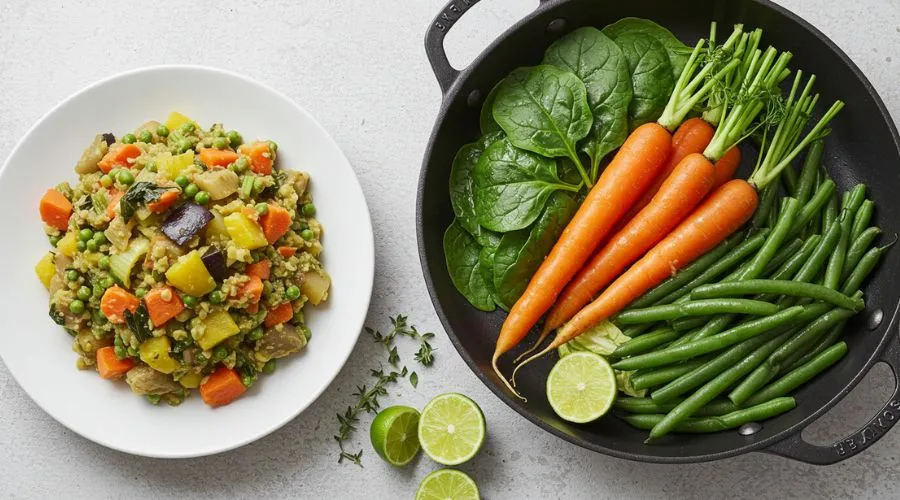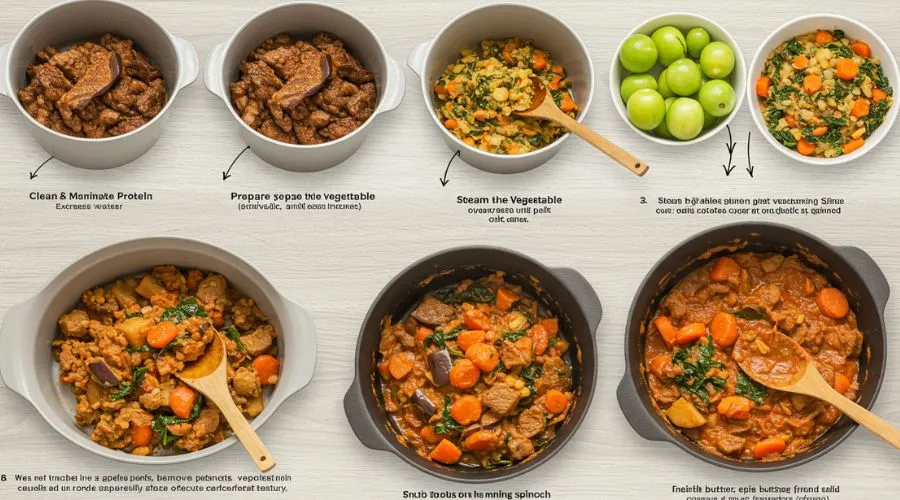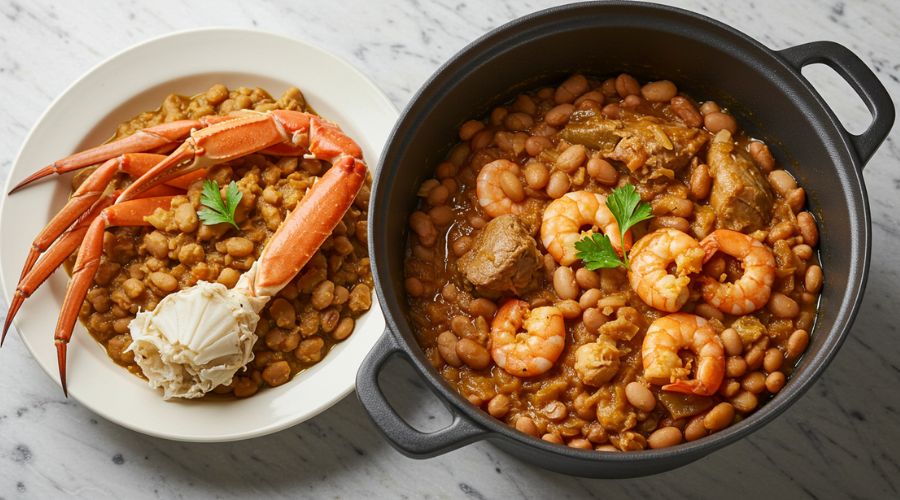Your Question is [What is Legume Haitian Food?] Legume, or “legim,” is a traditional Haitian dish that takes the form of a hearty vegetable stew, flavorful stew. It’s a lush combination of vegetables like Haitian eggplant stew, cabbage, carrots, spinach, and green beans, simmered to perfection with aromatic herbs and spices.
Often enriched with tender cuts of beef, fish, or seafood — or enjoyed as a purely vegetarian dish —legim (legume) is typically served with white rice or diri kolé (red beans and rice).
Celebrated for its versatility and nourishing depth, this dish is a proud representation of Haitian culinary tradition, marrying seasonal ingredients with bold, homegrown flavors.
But beyond this tidy definition lies a rich, dynamic story — one that we’re about to unpack together.
A Culinary Staple with Deep Roots
Legim (Legume) Haitian Food isn’t just another vegetable stew. In Haiti, it’s a cultural emblem, a dish woven into family gatherings, Sunday dinners, weddings, and festivals. It showcases the Haitian values of resourcefulness, community, and flavor.
Legumes Hiatian Food are closely associated with the country’s agricultural heritage. Vegetables like eggplant (berejenn), chayote squash (militon), spinach, and carrots grow abundantly in Haiti’s fertile lands.
Historically, these were combined with accessible proteins — beef, pork, or seafood — to create an easy Haitian vegetable dish that stretched across large families and communities.
What Makes Haitian Legume Unique?
Legume isn’t a one-note stew. It’s a vibrant, layered symphony of textures and flavors, marked by:
1. Versatility
Legume is adaptable — made with whatever is seasonal or on hand. Though essential vegetables include Haitian eggplant stew, chayote, carrots, and spinach, other ingredients like cabbage, string beans, collard greens, and green papaya may join the mix.
Proteins range from beef, pork, turkey, shrimp, and crab meat to vegetarian-only variations.
2. Complex Seasoning
The Haitian dish draws its soul from stewing with epis, a quintessential Haitian seasoning blend of garlic, scallions, peppers, thyme, parsley, and citrus juice. This marinade infuses meats and vegetables with a fragrant, herbaceous base that defines Haitian cuisine.
3. Slow, Patient Cooking
Legume demands time and care. The vegetables are first steamed or simmered to perfection, then mashed into a thick, textured mash. The marinated protein is sautéed until caramelized, and then everything is combined and slowly cooked down to deepen the flavors.
4. Flexible Pairings
Traditionally paired with white rice, diri kolé (red beans and rice), mais moulin (cornmeal polenta), or boiled/fried plantains, legume is a complete, satisfying meal that covers all nutritional bases.
Key Ingredients in Haitian Legume Explained

Let’s break down the stars of this dish: [What is Legume Haitian Food]
Eggplant (Berejenn) – Adds body and creaminess after being mashed.
Chayote Squash (Militon) – A mild, slightly sweet squash that blends beautifully.
Carrots – Bring natural sweetness and color.
Spinach – Adds earthy flavor and nutrients.
Cabbage – Optional, but adds volume and heartiness.
String Beans – Add crunch and vibrance.
Stewed with Epis (Haitian Seasoning Base) – The essential flavor backbone.
Tomato Paste – Adds color and deep umami.
Fresh Thyme, Garlic, Onions – Boost the aromatic factor.
Olive Oil/Vegetable– Used for sautéing.
Bouillon Cubes or Seasoned Salt – For depth and savory notes.
Citrus (Lime or Lemon) – Brightens flavors and cuts through richness.
Scotch Bonnet Pepper –There is an option for heat and a signature Caribbean kick. cuisine
How is Legume Prepared?
Though Haitian food recipes legumes vary by household, region, and personal taste, here’s a classic method — one both time-honored and practical:
Step-by-Step Process

1. Clean & Marinate the Protein
Meat is cleaned with lime juice and water, trimmed of excess fat, and marinated in epices, thyme, bouillon, and aromatics for at least 30 minutes.
2. Prepare the Vegetables
Vegetables like eggplant, chayote, carrots, and spinach are washed, peeled, and cut. We remove eggplant seeds and chayote cores carefully because they affect the texture.
3. Cook the Protein
The marinated meat is sautéed until caramelized, then braised gently with water or broth until tender.
4. Steam the Vegetables
The vegetables are layered over the meat, steamed until softened, then removed to be mashed separately.
5. Mash & Strain
Eggplants, chayote, and carrots are mashed into a thick paste, and excess liquid is strained.
6. Combine & Simmer
Mashed vegetables are returned to the pot with the meat, tomato paste, and spinach, cooking down into a thick, fragrant stew.
7. Final Seasoning
The easy Haitian vegetable dish is finished with butter, extra epis, salt, and scotch bonnet (optional), ensuring it’s balanced, flavorful, and rich.
8. Serve
Vegetables are traditionally served with white rice, diri kolé, mais moulin, or plantains.
Regional Legume Variations

No two Haitian kitchens produce legumes in the same way. Here are some common regional legume variations:
Legume with Crab Meat – Adds a sweet, briny note from fresh crab legs.
Legume with Turkey (Legim Kodenn) – Popular during holidays and large gatherings.
Legume with Shrimp or Conch – Coastal regions often favor seafood-based versions.
Vegetarian Legume – Omits animal protein but keeps the robust flavors.
Instant Pot Legume – A modern shortcut retaining the essence, cutting hours into minutes.
Nutritional & Cultural Value
Nutrition
Legume is a powerhouse meal packed with:
Fiber (from vegetables)
Protein (from meat, beans, or seafood)
Vitamins A, C, K (from spinach, carrots, and cabbage)
Minerals (iron, potassium, and magnesium)
Antioxidants (from eggplant and herbs)
It’s low in processed ingredients and naturally gluten-free, making it ideal for modern clean eating.
Cultural Significance of Legume
In Haiti, legume isn’t just sustenance — it’s storytelling through food. Each pot reflects local availability, family tradition, and resourcefulness. Its preparation fosters community bonds, often cooked in massive quantities for gatherings.
Why Legume Food Deserves Global Attention
Legumes in Haitian food are underrated gems in global culinary conversations. It stands proudly beside global stews like:
Ratatouille (France)
Caponata (Italy)
Moqueca (Brazil)
Jollof Stew (West Africa)
What sets it apart is its layered flavors, Haitian spice profile, and incredible versatility. In a time when plant-forward, nutrient-rich, traditional meals are in demand, legume offers a wholesome, satisfying, and culturally rich option.
Tips for Making Perfect Haitian Legume
Use Epis generously – it’s the dish’s heartbeat.
Choose Fresh Vegetables – Ripe, firm produce holds better flavor and texture.
Be Patient with Steaming & Mashing – This step defines the dish’s consistency.
Adjust Heat with Scotch Bonnet – A little goes a long way.
Pair Wisely – Traditional accompaniments like rice, plantains, and sos pwa (bean sauce pois) balance the flavors.
Conclusion of What is Legume Haitian Food?
Legume Haitian food is more than a dish — it’s a cultural legacy. Packed with vibrant vegetables, rich flavors, and the heart of Haitian kitchens, it deserves a place on global tables.
Whether prepared traditionally or adapted for modern lifestyles, legumes remain unchanged in essence: they are a warm, nourishing, and deeply satisfying expression of Haiti’s culinary soul.
Sources & Further Reading
Q1.What is Legume in Haitian Food?
Answer:
Legume, or legim, is a traditional Haitian vegetable stew made with a thick and flavorful blend of ingredients like eggplant, chayote squash, spinach, carrots, and cabbage. It’s typically simmered with herbs, spices, and Haitian seasoning called stewed with epis, and can include proteins such as beef, pork, crab, or shrimp.
The dish is mashed into a thick, savory mixture and served with rice, plantains, or cornmeal. It’s one of Haiti’s most loved, wholesome, and versatile meals.
Q2.What Ingredients Are Used to Make Haitian Legume?
Answer:
The most common Legume Haitian ingredients are:
Eggplant (Berejenn)
Chayote squash (Militon)
Spinach
Carrots
Cabbage
String beans
Haitian Epis (seasoning blend)
Tomato paste
Thyme, garlic, onions
Meat options (beef, pork, crab, turkey, or seafood)
It’s typically served with white rice, red beans and rice (diri kolé), or fried plantains.
Q3.Is Legume Healthy?
Answer:
Yes — Haitian Legume is considered a very healthy, balanced dish. It’s packed with fiber, vitamins A and C, antioxidants, and minerals from the mixed vegetables, plus lean protein when meat or seafood is included.
The dish is naturally gluten-free and can easily be made vegan by using vegetable stock and skipping the meat. Its nutrient density makes it an excellent choice for clean, wholesome eating.
Q4.Can You Make Haitian Legume Vegan or Vegetarian?
Answer:
Absolutely! Haitian Legume is one of the most versatile dishes in Haitian cuisine. You can easily make it legume vegan by removing the meat and using vegetable stock instead of broth. The rich flavors come from the combination of vegetables, epis, tomato paste, garlic, and thyme, so it remains a hearty vegetable stew and satisfying without animal products.
Common vegan legume Haitian ingredients include eggplant, chayote, carrots, cabbage, spinach, and string beans.
Q5.What Do You Serve with Haitian Legume?
Answer:
Legume is traditionally served with:
White rice (Diri blan)
Red beans and rice (Diri kolé)
Mais Moulin (Haitian cornmeal)
Fried or boiled plantains
Sos pwa (bean sauce pois)
These sides complement the rich, savory stew and turn it into a complete, satisfying meal perfect for family dinners or festive occasions.

